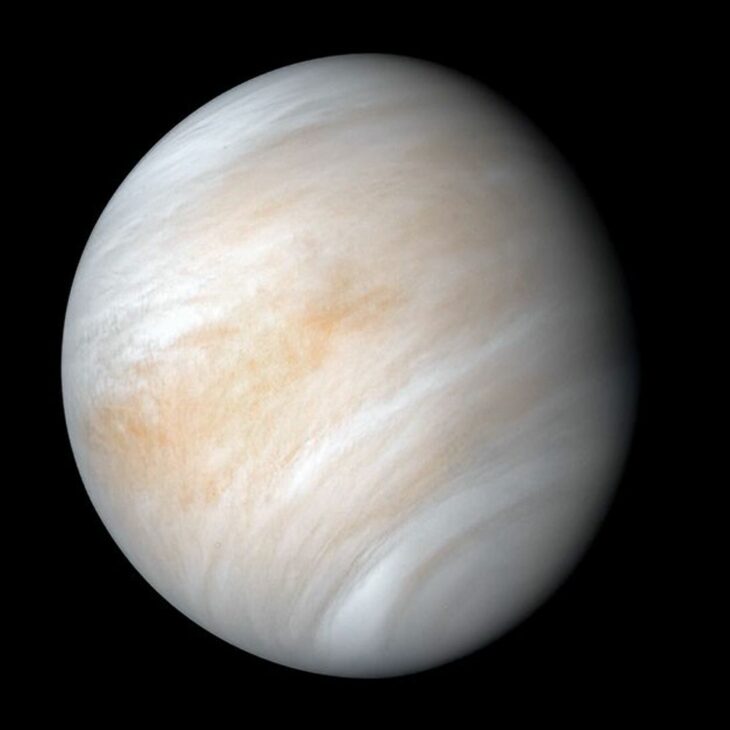Venus is one of 4 rocky planets in our solar system. Geologists think the geologic processes on Venus today might be similar to what Earth was like 4.5 billion years ago, soon after it formed. The Ishtar Terra highlands on Venus are an area of thickened crust about the size of Australia that is elevated about 4 kilometers (or 2.5 miles) above Venus’s surface and surrounded by long mountain belts about 10 kilometers (or 6 miles) high. These highlands are similar to Earth’s largest plateau, the Tibetan Plateau, which is about 4.5 kilometers (or 3 miles) high, and covers an area of about 2.5 million square kilometers (or 1 million square miles).
Although the Tibetan Plateau and the Ishtar Terra highlands are similar landforms, researchers think they must have formed by different processes. Scientists have shown that the Tibetan Plateau formed from the collision of tectonic plates on Earth, but Venus has no tectonic plates. Researchers analyzed geophysical surveys of the Ishtar highlands and found that it is supported by more buoyant rock beneath it. Scientists think this buoyant rock could be left over from magmatic processes that created the thick crust, but they’re uncertain. They want to know how Venus’s crustal highlands formed to better understand how rocky planets like Earth evolve and change.
Researchers in the past focused on either magmatism or tectonic processes on Venus to explain how the highlands developed, but none have proposed a model linking these processes. Fabio Capitanio and collaborators aimed to generate just that – a model that links both tectonic and magmatic processes, called a geodynamic model.
To test which large-scale processes produced the Ishtar highlands, the team used a geodynamic model that successfully simulated how thick crust formed on Earth. This model is called a 3D Cartesian model. They adapted the model for an area of 3,650 by 3650 kilometers (or 2,268 by 2,268 miles) and a depth of 730 kilometers (or 453 miles), approximating the Ishtar highlands.
In each model, they input parameters like density and viscosity based on Earth conditions and adjusted for the higher surface temperatures on Venus, which are around 450°C or 840°F. They ran 34 models of the Ishtar highlands for 1 billion years each and observed how elevation, gravitational features, and temperature changed through time. Using this model, the team was able to successfully reproduce the elevation and gravitational features of the Ishtar highlands.
Next, they checked the different model results to see what processes produced these features over time. They found that the numerical model that best simulated highland formation on Venus was one in which the planet’s outermost layer, called the lithosphere, was 10 to 50 times weaker than Earth’s. In this model, very hot rocks in the planet’s interior rose, causing its weak lithosphere to stretch and become thinner as it heated up.
The team explained that when Earth’s strong lithosphere stretches, it can open slightly to create a volcano that erupts small amounts of lava at the surface. However, when Venus’s weak lithosphere stretches, it breaks apart over a much larger area. When the lithosphere breaks apart, rocks that were once under too much pressure to melt move closer to the surface and melt into magma.
The researchers proposed that this stretching and melting scenario could explain how Venus’s Ishtar highlands formed. As the magma in this area cooled, it formed Venus’s new, very thick, crust. This crust, now different from the lithosphere, acted more like puddy and was difficult to move around, so it resisted the same stretching and thinning that the old lithosphere couldn’t.
The team suggested this scenario could also explain why more buoyant rocks are found beneath the Ishtar highlands. The new crust would be held up by more buoyant rocks even deeper in Venus’s interior that didn’t melt, giving the crust its high elevation. Meanwhile, the old lithosphere that broke apart would squish through Venus’s surface, compressing everything around it. They suggested this uplift could have formed the long mountain belts found on the margins of the Ishtar highlands.
The researchers concluded that Venus’s highlands formed after the weak lithosphere broke apart and rocks deep in its interior melted. Other highlands on Venus may have formed similarly. Although Earth’s modern plateaus formed very differently from the Ishtar highlands, they suggested plateaus that formed on Earth 4.5 billion years ago may have been similar since early Earth was hotter and may have had a weaker lithosphere.


